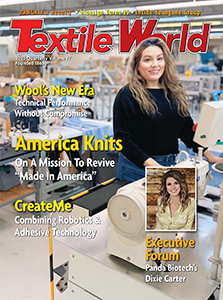SALT LAKE CITY — July 26, 2017 — The Taiwan External Trade Development Council (TAITRA) hosted the Taiwan New Products Launch at the Outdoor Retailer Summer Market in Salt Lake City. Four of Taiwan’s leading textile manufacturers presented innovative products: Far Eastern New Century Corp.; QMI Industrial Co. Ltd.; Singtex Industrial Co., Ltd.; and Tex-Ray Industrial Co., Ltd.
New product categories included cutting-edge fabric printing technology; smart textiles measuring heart rate and motion data; textile innovations utilizing fewer chemicals, water and raw materials while preserving function and complex colors; and the world’s first PFC-free durable water repellant (DWR) polyester filament, PFC-free soil release polyester filament, and bio-based membrane and foam from coffee oil.
The program began with distinguished speakers presenting welcome remarks and the vision for Taiwan’s textile industry.
Simon Lai, executive director, Taiwan Trade Center, San Francisco thanked attendees for their interest in Taiwan’s new product showcase. “Today, we are introducing breakthrough products and materials that represent the best of Taiwanese textile innovation,” Lai said. “The Outdoor Retailer Summer Market is the perfect setting for new partnerships.”
Joseph C.L. Ma, director-general, Taipei Economic and Cultural Office, San Francisco remarked: “With a global growing trend in eco-friendliness, Taiwanese suppliers have devoted research and development to green technologies to meet customer demands and achieve goals of sustainability and corporate social responsibility.” Ma emphasized Taiwan’s competitive advantage in functional, environmental, and smart fabrics comes from its strong development of functional artificial fibers, which helps produce a wide variety of fabrics. Taiwan’s fabric industry also incorporates semiconductor, biomedical and cross-industry innovations. “Today’s event provides a good platform for Taiwanese manufacturers and the global outdoor industry to foster more collaborations,” he concluded.
Melissa Wang, deputy director, Market Development Department, Taiwan Textile Federation presented “The Vision of Taiwan Textile Industry,” including product differentiation, design and creativity, function combined with eco-consciousness, and branding.
Special guest, Derek Miller, president of the World Trade Center, Utah spoke about the importance of international trade to Utah and its successful relationship with Taiwan.
Four of Taiwan’s leading textile manufacturers presented innovative products.
Far Eastern New Century Corp. presented two world-first products. FENC ® TopDry® Zero is the world’s first PFC-free DWR polyester filament. The polymer is intrinsically water-repellent, offering permanent and superior DWR performance. FENC TopClean is the world’s first PFC-free polyester filament allowing for easy soil removal. The polymer naturally eases removal of soil and stains when soaked in pure water, while offering superior nylon-like comfort. Additionally, the company showcased FENC DynaFeed™ which uses a highly durable ultra-thin organic matrix to seamlessly and sustainably integrate the textile world with the digital. The DynaFeed directly measures real-time performance information during training, which is then displayed in an app the athlete can use to fine-tune performance.
QMI Industrial Co. Ltd. presented The Aqua Terra fabric and the Roam Anywear Hood, two of the latest VAST Tech developments. Created with the user in mind, they allow active nature lovers to get closer to nature in their busy lives. Marrying function with form, the Aqua Terra fabric and Roam Anywear Hood offer minimalist designs, fusing multiple functions into singular products. They effectively limit the amount of production resources needed, making them environmentally friendly. Aqua Terra is a fabric for garments that go from the mountains, to the oceans, to the office. The Roam Anywear Hood easily inflates to become a pillow.
Singtex Industrial Co., Ltd. presented three products. The AIRMEM™, the latest innovation from S.Café®, pushes textiles to a new level. Twenty-five percent of the material is comprised of coffee oil extracted from spent coffee grounds. Its membrane replaces petroleum-based materials with a more sustainable alternative. Twenty-five percent of S.Café’s bio-foam, The AIRNEST™, is derived from the sustainable source of coffee oil. The AIRNEST presents a new alternative to petroleum-based ingredients, while providing a high-performance textile. The AIRNEST applies to a wide range of functionality and end-user markets. S.Café’s innovation continues with its cutting-edge fabric printing technology, the P4DRY™. Repurposed coffee grounds give the print layer four key attributes: it dries quickly, controls odor, reduces the rate of condensation, and is tremendously sustainable.
Tex-Ray Industrial Co., Ltd., by 2020, will improve its environmental footprint by reducing water usage and decreasing CO2 emissions during raw material production. Texray Performance Green House supplies and presented a series of collections that maintain their beauty and performance while being non-toxic. The Eco series can be divided into three categories: less chemicals with more function, represented by T-Cool and T-Hot fabrics; less water with fancy colors, represented by the ECO-lor dyeing technology; less raw material usage, represented by Recycle Poly with Blue Dye products.
Exhibitors and attendees from the industry remarked it was impressive to hear the overview of Taiwan’s textile industry and learn about the innovative eco-products and materials discussed in the presentations and displayed in the demos.
According to estimates of the Taiwan Textile Research Institute’s ITIS research team (April, 2017), the output value (including overseas production) of Taiwan’s functional fabrics accounted for roughly 50 percent of the global output value of functional fabrics, making Taiwan the world’s largest functional fabric production base.
Posted July 26, 2017
Source: The Taiwan External Trade Development Council (TAITRA)




